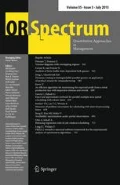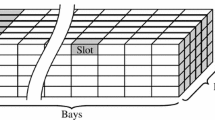Abstract
In this paper, a storage yard planning problem is studied for a transshipment port with limited space and high-throughput level. Generally, the consignment strategy is used in the yard for a transshipment port, where containers to the same destination vessel are stored together. This is to facilitate faster loading process as it reduces reshuffles as well as long distance movements of yard cranes. However, the consignment strategy is known to be inefficient in space utilization since each storage location must be dedicated to a particular vessel. To improve the space utilization while retaining the advantage of consignment, a new approach named the “flexible space-sharing strategy” is proposed. The idea is that the container space can be shared by two different vessels as long as their containers do not occupy the space at the same time. This strategy allows the same storage location to be reserved for two vessels. The amount of space will only be allocated to a specific vessel on the arrival of corresponding containers. By controlling where to stack the containers in the storage locations, the containers to each vessel are not mixed and the consignment feature can be preserved. This strategy is first formulated as a mixed integer program (MIP). As the MIP model has a block diagonal structure, we develop a search algorithm which combines MIP and heuristics to find the solution. The numerical experiments show that the “flexible space-sharing strategy” can handle much more containers within the same storage space compared with the “non-sharing strategy”.












Similar content being viewed by others
References
De Castilho B, Daganzo CF (1993) Handling strategies for import containers at Marine Terminals. Transp Res Part B 27:151–166
Dekker R, Voogd P, Asperen E (2006) Advanced methods for container stacking. OR Spectr 28:563–586
Han Y, Lee LH, Chew EP, Tan KC (2008) A yard storage strategy for minimizing traffic congestion in a marine container transshipment hub. OR Spectr 30:697–720
Jiang X, Lee LH, Chew EP, Tan KC, Han Y (2012) A container yard storage strategy for improving land utilization and operation efficiency in a transshipment hub port. Eur J Oper Res 211:64–73
Kim KH (1997) Evaluation of the number of reshuffles in storage yards. Comput Ind Eng 32:701–711
Kim KH, Kim HB (1999) Segregating space allocation models for container inventories in port container terminals. Int J Prod Econ 59:415–423
Kim KH, Kim HB (2002) The optimal sizing of the storage space and handling facilities for import containers. Transp Res Part B 36:821–835
Kim KH, Park KT (2003) A note on a flexible space-allocation method for outbound containers. Eur J Oper Res 148:92–101
Kozan E, Preston P (1999) Genetic algorithms to schedule container transfers at multimodal terminals. Int Trans Oper Res 6:311–329
Kozan E, Preston P (2006) Mathematical modeling of container transfers and storage locations at seaport terminals. OR Spectr 28:519–537
Lee LH, Chew EP, Tan KC, Han Y (2006) An optimization model for storage yard management in transshipment hubs. OR Spectr 28:539–561
Lim A, Xu Z (2006) A critical-shaking neighborhood search for the yard allocation problem. Eur J Oper Res 174:1247–1259
Preston P, Kozan E (2001) An approach to determine storage locations of containers at seaport terminals. Comput Oper Res 28:983–995
Sculli D, Hui CF (1988) Three dimensional stacking of containers. Omega Int J Manag Sci 16:585–594
Stahlbock R, Voß S (2008) Operations research at container terminals: a literature update. OR Spectr 20:1–52
Steenken D, Voß S, Stahlbock R (2004) Container terminal operation and operations research—a classification and literature review. OR Spectr 26:3–49
Vis IFA, de Koster R (2003) Transshipment of containers at a container terminal: an overview. Eur J Oper Res 147:1–16
Wan Y, Liu J, Tsai PC (2009) The assignment of storage locations to containers for a container stack. Nav Res Logist 56:699–713
Won SH, Zhang X, Kim KH (2011) Workload-based yard-planning system in container terminals. J Intell Manuf. doi:10.1007/s10845-011-0565-x
Zhang C, Liu J, Wan YW, Murty KG, Linn RJ (2003) Storage space allocation in container terminals. Trans Res Part B 37:883–903
Author information
Authors and Affiliations
Corresponding author
Rights and permissions
About this article
Cite this article
Jiang, X., Chew, E.P., Lee, L.H. et al. Flexible space-sharing strategy for storage yard management in a transshipment hub port. OR Spectrum 35, 417–439 (2013). https://doi.org/10.1007/s00291-012-0308-1
Published:
Issue Date:
DOI: https://doi.org/10.1007/s00291-012-0308-1




